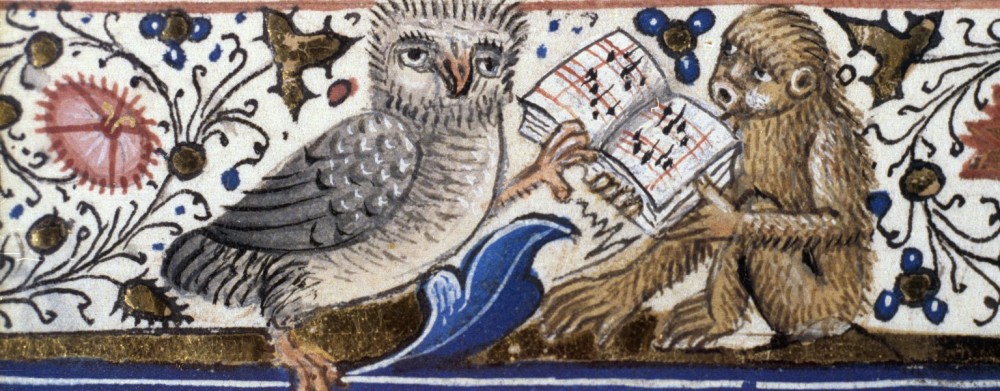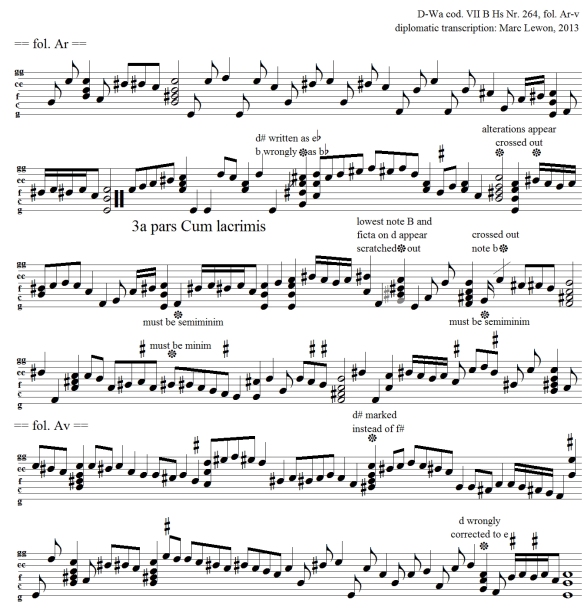[The Wolfenbüttel Lute Tablature is arguably the earliest extant source for lute music in Western Europe and, even though it survives merely as a fragment, the only known specimen of the tablature system described in the Kassel Collum Lutine. In his article “Norddeutsche Fragmente mit Lautenmusik um 1460 in Wolfenbüttel” from 2011 Martin Staehelin presented this tablature and concluded that it was intended for the lute.[1] The fragment, which Staehelin dated to c1460, survived as a pastedown on a host codex from St. Cyriacus in Brunswick and is now at the Staatsarchiv Wolfenbüttel under the shelfmark cod. VII B Hs Nr. 264. For more information on the source see the introductory entry to this blog series.]
The fragment of the Wolfenbüttel Lute Tablature on fol. Ar-v features the second half of a lute arrangement of Johannes Ciconia’s famous two-voice ballata “Con lagrime bagnandome nel viso” with a text by Leonardo Guistinian, here latinised to “Cum lacrimis”. The numerous concordances, according to David Fallows’ “Catalogue of Polyphonic Songs”,[2] also include four intabulations in the Buxheimer Orgelbuch [Bux 38, 137, 138, 139] and one in the Locham Song Book [Loch 73]. Apparently this Italian composition was quite popular in German speaking lands and as an instrumental arrangement no less, which is surprising since the contrapuntal effects appear to be idiomatic for vocal performance and do not seem to lend themselves easily to presentation on a solo instrument. Maybe its success was owed to the hoquet passages, which must have had a certain appeal, especially when performing the piece as a sort of question-and-answer game on the plectrum-lute, resulting in something like an “alternating monophony”.
Most of the tablatures add a third voice to the two-part texture, thus changing the appearance of the setting significantly. The version in the Wolfenbüttel Lute Tablature covers a middle ground by mainly keeping the two-voice structure while occasionally adding full chords—probably partly to enrich the fabric of the setting and partly due to technical reasons, namely to bridge over intermediate courses in order to enable the strumming of split chords with one stroke of thumb or plectrum. It is interesting to note, that the intabulation of Ciconia’s “Con lagrime” was divided into three formal units while the original chanson has only two. Most of the other German organ intabulations agree with Wolfenbüttel in this tripartition created by subdividing the first original formal unit after the 18th brevis. Even though only the last part of the piece survives here, one can safely assume that the Wolfenbüttel version did the same, since the last part ist labelled “tercia pars”. However, Wolfenbüttel is unique in having a repetition sign after the “secunda pars”. The question of whether only the secunda pars was meant to be repeated or the prima pars also (the only part which is repeated in some of the other organ tablatures) must remain unresolved.
The beginning of the composition is missing, having stood on the now lost facing verso page of an original opening. Despite the stains left over from the glue which once had attached the paper to the inside of the binding of the host codex, the surviving notation is clearly decipherable in the colour scan:

D-Wa cod. VII B Hs Nr. 264, fol. Ar (reproduction with kind permission of the Staatsarchiv Wolfenbüttel)—secunda pars and beginning of “tercia pars” of the lute intabulation “Cum lacrimis” (= “Con lagrime bagnandome nel viso” by Johannes Ciconia).

D-Wa cod. VII B Hs Nr. 264, fol. Av (reproduction with kind permission of the Staatsarchiv Wolfenbüttel)—end of “tercia pars” of the lute intabulation “Cum lacrimis” (= “Con lagrime bagnandome nel viso” by Johannes Ciconia).
A diplomatic transcription enhancing the manuscript’s spacing of the notes reveals the nature of the “strike notation” used. It only regulates the relative time interval between two struck notes or chords and does not supply voice leading—a feature it shares with other systems of lute tablature. Most of the necessary musica ficta is already marked in the source by little diagonal strokes under individual notes or by a “second note head” to the right in the case of notes that are bound in a chord (the Kassel Collum Lutine confirms this interpretation).
Since the tablature notation uses the note “Gamut” as an equivalent to the lowest string of the instrument, the setting appears in a much lower register than it would have been heard. When assuming a five-course lute in A—which would be typical for a lute of the late 15th century, as Francesco Spinacino’s tablatures from 1507 and Sebastian Virdung’s Musica getutscht from 1511 testify—the “Gamut” would actually be up a fifth on d.
The following polyphonic transcription unravels the sometimes confusing mist created by “strike notation” and shows how the polyphonic texture, with its complete cantus and tenor line, is embedded in the tablature. The voice leading is entirely clear now:

Polyphonic transcription of “Cum lacrimis” with silent corrections from D-Wa cod. VII B Hs Nr. 264, fol. Ar-v. The ornamented cantus line is presented in the upper system, while the tenor (in red) and the occasional contratenor material share the lower system.
The long, rhythmically hoqueting runs towards the cadences of each section, with their characteristic change of texture, is highly reminiscent of the intabulation techniques used in a number of pieces from the Buxheimer Orgelbuch, where the contratenor voice rests while cantus and tenor are engaged in a battle of rhythmical wit.
A comparison of the Wolfenbüttel Lute Tablature with the original ballata by Ciconia reveals how closely the intabulation is modelled on the chanson. Admittedly, the tablature takes liberties: See for example bar 48 where the cantus motif is transposed down by a fourth, resulting in parallel 3rds rather than parallel 6ths. This could be due to the desire to avoid “splits” on the lute and to place simultaneous notes on neighbouring courses, which can easily be plucked with a plectrum. The tablature also misses out or adds the occasional brevis (see bars 43, 53-54, 74), but the overarching structure can be traced very well throughout the surviving parts:

Synopsis of the surviving parts of the tablature “Cum lacrimis” (WolfT 1) with the ballata “Con lagreme” (Johannes Ciconia). The respective tenor parts are marked red and Ciconia’s ballata is transposed down a third to facilitate the comparison.
The conversion of the above polyphonic transcription to a lute tablature that attaches each note to a specific place on the fingerboard (such as French lute tablature) makes it easy to see that this arrangement fits the lute particularly well. The setting is arranged in a way that nearly all simultaneous notes fall on neighbouring courses, enabling the player to strum them with a finger or plectrum. Only in two places does a “split” occur: in the middle of lines 2 and 4. The first of these places, however, can easily be circumvented by muting the intermediate, second course with the same finger that frets the lowest string, which would happen almost automatically anyway. The second place could be solved by merely fretting the intermediate string on the second fret:

Conversion of “Cum lacrimis” into French tablature notation adapted for a five-course lute (©Marc Lewon, 2012).
With Ciconia’s ballata version as a reference, I mostly used the intabulation of Bux 137 for my reconstruction of the missing first half of the piece. By comparing all surviving versions of “Con lagreme” Bux 137 turned out to be the nearest cognate to our Wolfenbüttel arrangement, thus supplying stylistically closely related input for a convincing reconstruction.
 This work is licensed under a Creative Commons Attribution-NonCommercial-ShareAlike 4.0 International License.
This work is licensed under a Creative Commons Attribution-NonCommercial-ShareAlike 4.0 International License.
[1] Staehelin, Martin: “Norddeutsche Fragmente mit Lautenmusik um 1460 in Wolfenbüttel”, in “Kleinüberlieferung mehrstimmiger Musik vor 1550 in deutschem Sprachgebiet”, Series IX, “Neue Quellen des Spätmittelalters aus Deutschland und der Schweiz” (= Abhandlungen der Akademie der Wissenschaften zu Göttingen, Neue Folge, Band 15), Berlin 2012, pp. 67-88 (text and edition) and pp. 141-144 (facsimile).
[2] Fallows, David: A Catalogue of Polyphonic Songs, 1415-1480, New York (Oxford University Press) 1999, p. 509.


Lieber Marc,
dies ist faszinierend! Was für tolle Arbeit Du immer leistest!
Herzlich,
Karin
Pingback: An Assessment of the Wolfenbüttel Lute Tablature | mlewon
Pingback: Dotted Rhythms and Rests | mlewon